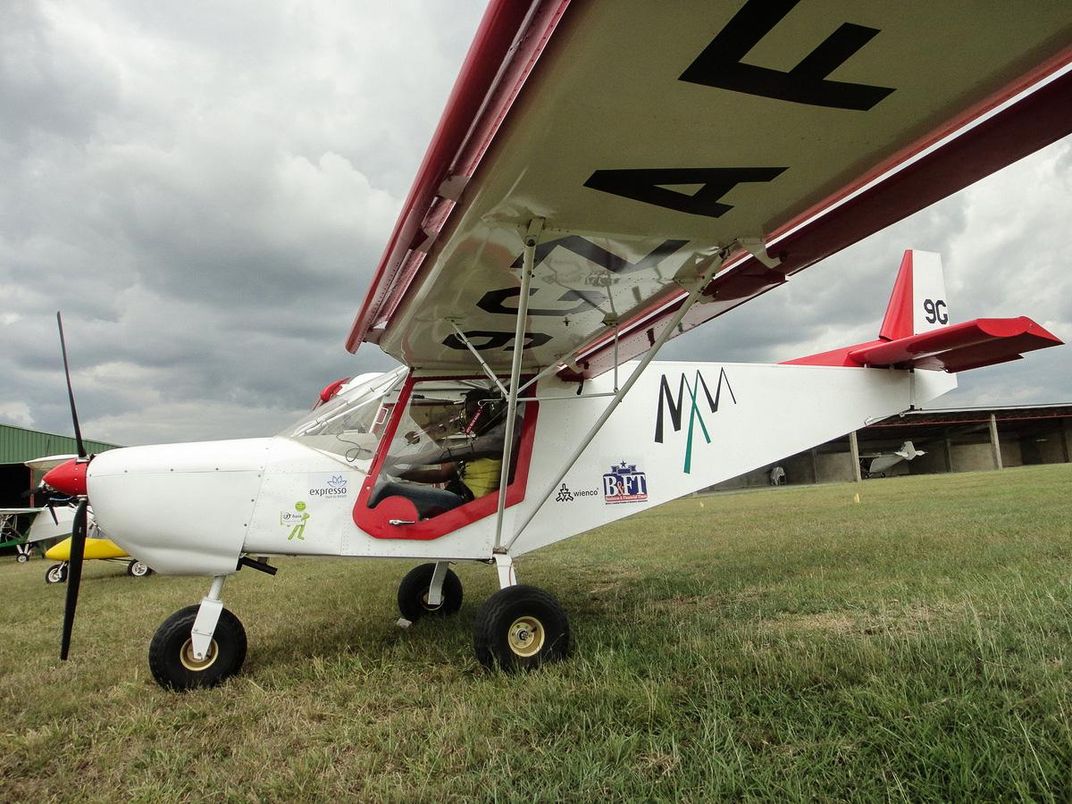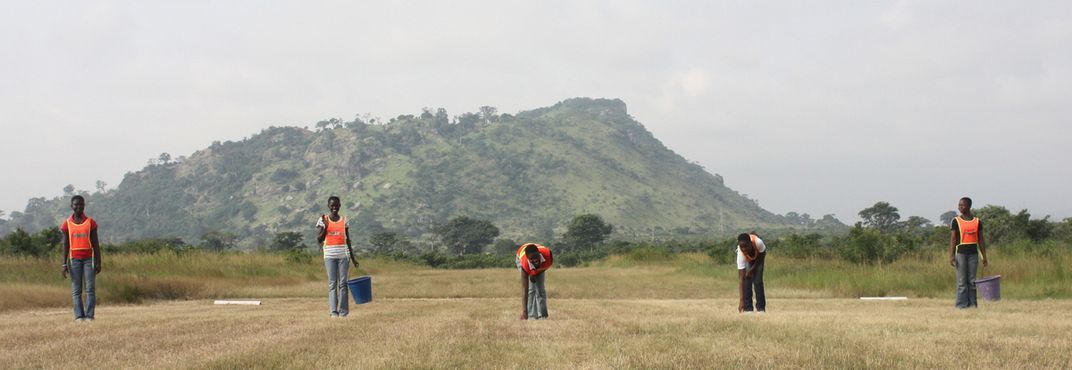A Ghanaian Woman’s Quest to Work—and Fly
How Patricia Mawuli beat the odds to become an airplane builder and airport manager.
:focal(560x257:561x258)/https://tf-cmsv2-smithsonianmag-media.s3.amazonaws.com/filer/13/5a/135a6ebd-a45e-4850-9fd0-94cbacf475d7/17c_aug2015_patriciaanothersuccessfulflight_live.jpg)
“Engine failure! Engine failure!” I shouted into the radio as I pulled the power on my 80-horsepower Rotax boxer engine back to idle. We were at less than 1,000 feet, climbing from a grass strip at Kpong Airfield in Ghana, West Africa. The baobab tree below reached out its naked branches like it wanted to claw us from the sky.
Kweku, the young student next to me, pushed the stick forward as he’d been trained to do. We set our airspeed for 55 knots, the best glide/survive speed in these conditions, and the ground filled the windshield. The air-on temperature was over 100 degrees Fahrenheit, and the humidity around 90 percent. Although we were only a few hundred feet above sea level, the heat and humidity made our aircraft behave as though flying at 3,000 feet. Add to that the threat of wind shear, thermals, large vultures, and black kites, and the term “glide/survive” no longer seems like an abstraction.
On the ground, I could see a young lady dressed in a pale green school sports shirt, jeans, and flipflops. She appeared to be in her late teens or early 20s; I would later learn she did not know her exact age, as she never had a birth certificate. Her father had died when she was just a few months old. Her mother had left her village soon after. The relatives who’d raised her knew her to be a little troublesome. That morning, she had risen from her straw bed inside the mud-and-thatch hut she called home, fetched water, carried it home on her head, cooked food over an open fire, and went back out to collect firewood to sell in the hope of earning a few cents. Her name was Patricia Mawuli.
Hearing the engine noise above her, Patricia looked up through the canopy of a Gliricidia tree. She had never seen an aircraft so low in the sky. It made her heart beat faster, flooding her with fear but also curiosity. “Why are they chasing me?” she wondered.
In the cockpit, the altimeter was spiraling. “Where are we going?” I kept asking the young pilot, sounding more alarmed each time I asked the question. Kweku’s deep brown eyes told me he was afraid too. He couldn’t see the large clearing I had hoped he would select for our landing. As the available height dropped below my comfort zone, I finally declared, “I have control.”

Kweku exhaled audibly, having held his breath for an extended period. I eased the throttle forward and pulled back on the stick until we climbed at a safe speed. At 600 feet, the altitude at which pilots enter the pattern for Kpong field, we entered downwind, turned base, then final, and landed. Neither of us said a word. (I was saving mine for later.) And neither of us were aware of the girl who’d seen us, nor of the societal change she would inspire.
Later that day, Patricia found her way to the airfield. She walked to the briefing area and hopped from one leg to the other, trying to get attention. I was not only the flight instructor but also the airfield manager, toilet cleaner, and general dogsbody. I’d gotten this illustrious job by bringing together the group of investors who paid to build the airfield in the first place; they decided I ought to run it too.
Patricia looked at me and said, “I want a job.”
“We don’t employ women,” I replied.
West Africa really is a “man’s world,” and I confess it didn’t occur to me that a woman could work in an airfield, let alone want to try. In that part of the world, women are to remain at home or, if they must work, do so in a field such as petty trading. I did not challenge this view then.
“I will work for free,” Patricia said, looking me straight in the eye.
“Okay,” I said. “Here is a machete and a pickax. Go and clear trees so that we can extend the runway.”
She smiled and amended her salary request: “But only if I can see the flying machines.” The deal was struck, implementing a permanent change in our hiring policy.
That day, Patricia cleared more trees than the men performing the same task. She did the same the next day. And the next. She came early, she left late, she studied each aircraft on the site, and lifted her head from her labors to watch every takeoff and landing. I put her on the payroll as a field hand.
A few weeks later I was in my workshop, teaching a young man how to assemble an airplane. I accidentally knocked his bag on the floor. Spare parts spilled out—stolen spare parts, from the look of it; things he would have no need to carry home with him. I sent him to the police station. In these conditions, swift decisions are as necessary on the ground as in the air.
I was left alone, struggling to fix some cotter pins to the airframe. I needed a second pair of hands. Outside the window, I could hear tall grass being sliced with a machete. I looked out and saw Patricia, clearing overgrowth like a human bulldozer.
“Oi, you,” I barked. “Come here and hold this wing.”
She lit up at the invitation to enter the workshop. Leaving her machete at the entrance, she took hold of the parts necessary and assisted. Before I knew it, she had inserted the pins and other fixtures with the dexterity of a seasoned mechanic. “Where did you learn to do that?” I asked.
“I watched you,” she said, rightly proud of herself.
I invited Patricia to become my apprentice, a full-time, paid position. Sadly, her family did not want her to work in a “man’s profession,” and she had to leave home to pursue this opportunity. Achievement often demands sacrifice; Patricia’s sacrifice was massive, and life-changing.

She learned to build airplanes, and soon became the first woman to earn a Ghana National Pilots License and to instruct other pilots. Later she found international fame as the first woman certified by Rotax Aircraft Engines as an Independent Rotax Maintenance Technician; credentialed to install and repair Rotax aircraft engines.
After five years of working together at the airfield, we quietly started to date. We were married in September 2012. I had been gruff and dismissive to her in the earliest days of our relationship, but she had earned my respect and love, as I had earned hers. In December 2013 she was appointed Managing Director of Operations at Kpong Airfield. For a woman to be selected for that position would’ve been unthinkable when she’d first shown up there six years earlier. Today, she looks for women who have the drive to succeed as she has, if only given the opportunity.
Last summer, just eight years after seeing my aircraft bearing down on her through the trees, Patricia was invited to the Experimental Aircraft Association AirVenture fly-in in Oshkosh, Wisconsin, where she led a team of young Americans with no prior aircraft building experience in the “One Week Wonder” soup-to-nuts assembly of a Zenith CH750.
Kweku, my student on the day of that fateful exercise, never did develop the quick decision-making ability he needed to earn his license. But if he hadn’t flown with me during that engine failure, the engine-start in the life of Patricia Mawuli might never have happened.
Jonathan Porter manages the Rotax Aircraft Engine distributorship for the United Kingdom, Ireland, Iceland, and West Africa.